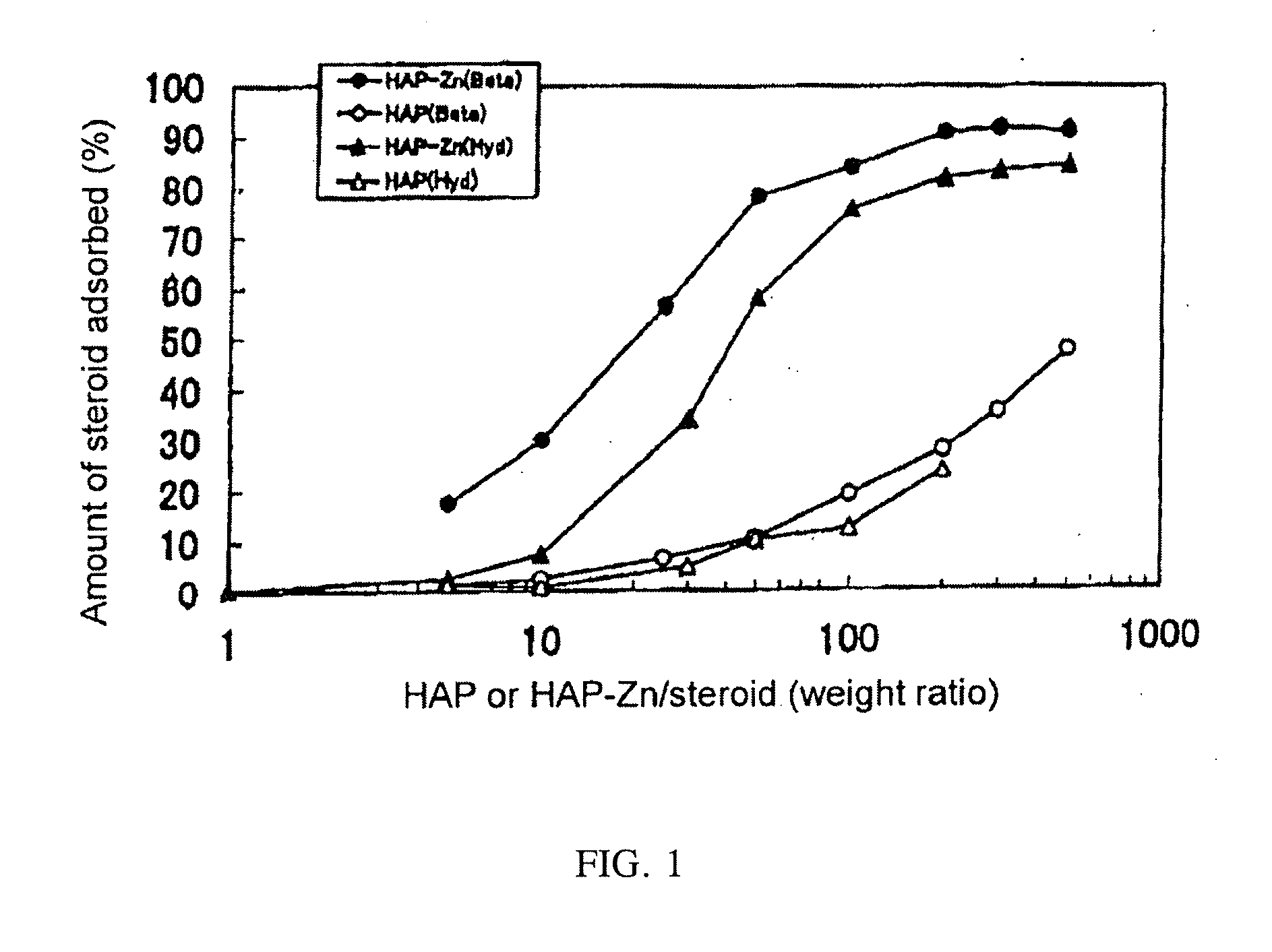Drug-containing sustained release microparticle, process for producing the same and preparation containing the microparticle
a technology of sustained release and microparticles, which is applied in the direction of drug compositions, peptide/protein ingredients, inorganic non-active ingredients, etc., can solve the problems of inactivation becoming a problem, excessive release, and difficult preparation to administer
- Summary
- Abstract
- Description
- Claims
- Application Information
AI Technical Summary
Benefits of technology
Problems solved by technology
Method used
Image
Examples
example 1
[0024]A betamethasone phosphate or hydrocortisone phosphate aqueous solution (100 μL, 100 μg / mL) was mixed with a water suspension (100 μL) of a given amount of porous hydroxyapatite (HAP) or porous apatite derivative with substitution by 0.5 mol of zinc (HAP-Zn-0.5) and left at room temperature for 10 minutes, followed by centrifugation at 2500 G to determine betamethasone phosphate or hydrocortisone phosphate liberated in the resulting supernatant from the absorbance of the supernatant at 230 nm. The amount of the drug remaining after the given amount of the drug initially applied washed away in the supernatant was used as the amount of the drug adsorbed. The result is shown in FIG. 1. As can be seen from FIG. 1, a larger amount of the HAP or the porous apatite derivative relative to the drug allowed the adsorption of the drug into the HAP or the porous apatite derivative at a higher ratio. The porous apatite derivative had an adsorption ratio significantly higher than that of the...
example 2
[0026]After 45 mg of porous hydroxyapatite (HAP) or porous apatite derivative (derivative with substitution by or content of 0.5 mol of zinc (HAP-Zn-0.5)) was accurately weighed and supplemented with 2.4 mg / mL interferon a (IFN) solution (30 μg in terms of the amount of IFN), the resulting mixture was left for 10 minutes. This mixture was then supplemented with 1 mL of 20 mM zinc acetate solution and shaken for 30 minutes. This dispersion was supplemented with 1.5 mL of water and washed to quantify IFN in the washed solution. As a result, IFN was not detected in both of the HAP and the HAP-Zn-0.5. Namely, it was confirmed that the whole amount of IFN was adsorbed into the HAP or the HAP-Zn-0.5. As described above, the drug-containing microparticle in which IFN, a protein, was adsorbed could be obtained without the use of organic solvents. After washing, 20 mL of a PBS solution containing 20% FCS was added to the obtained powder and shaken at 37° C. for 16 hours. IFN eluted into the ...
PUM
| Property | Measurement | Unit |
|---|---|---|
| particle size | aaaaa | aaaaa |
| particle size | aaaaa | aaaaa |
| particle size | aaaaa | aaaaa |
Abstract
Description
Claims
Application Information
 Login to View More
Login to View More - R&D
- Intellectual Property
- Life Sciences
- Materials
- Tech Scout
- Unparalleled Data Quality
- Higher Quality Content
- 60% Fewer Hallucinations
Browse by: Latest US Patents, China's latest patents, Technical Efficacy Thesaurus, Application Domain, Technology Topic, Popular Technical Reports.
© 2025 PatSnap. All rights reserved.Legal|Privacy policy|Modern Slavery Act Transparency Statement|Sitemap|About US| Contact US: help@patsnap.com

